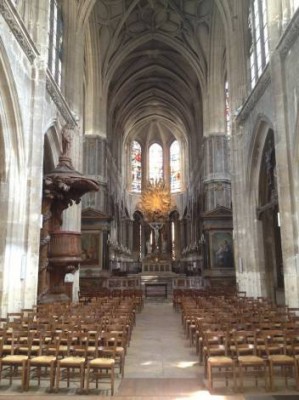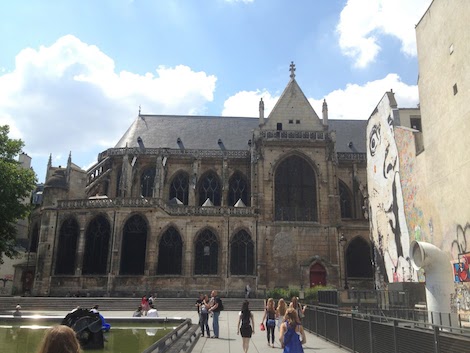PARIS, FRANCE. At the north end of Paris’ 4th arrondissement, just a stone’s throw away from the massive eyesore that is the Centre Pompidou, there sits a church half-encrusted in buildings. To look at it from the north, you might confuse it with the famous Notre Dame cathedral. The vaulted windows and flying buttresses of the two look so similar, in fact, that this smaller version has been nicknamed “Notre-Dame la Petite” or the little Notre Dame. This is the Church of Saint-Merri, and I believe that, in this modern day and age, there is a lot that the Roman Catholic Church as a whole can learn from its example.

Interior of the Church of Saint-Merri
Now, I’ve never been very religious, but old churches have always grabbed my attention. I make a habit of ducking into every one that I see, to see what interesting things I can find. This started back in 2009 when I visited Rome. I’ve always been amazed by the history you can find carved into every nook and cranny of these stone-walled places of worship. From intricate marble statues and priceless paintings, to the tombs of famous historical figures, old European churches are monuments to the wealth and power of the Catholic Church of the past. And even though, as of late, the Church doesn’t hold nearly as much power as it once did, each and every Catholic building I had visited had always been meticulously up kept. This was often even to the point of my annoyance, repair scaffolds seldom make for pretty pictures. But it was the striking difference that I discovered in visiting this church that caught my interest.
The first thing that I noticed was that the front façade was covered with bird netting, as are the organ pipes above the doorway. The large, main doors of the church were wide open, something I have never seen, other than at the heavily trafficked Saint Peter’s Basilica. This, combined with a pigeon or two fluttering about inside, gave the feeling that this church was, to quote one yelper, “a completely public space.”
Inside, the alcoves were dimly lit. The sun was streaming in through the stained glass windows, but the small side altars were dusty and most look unused. However, most notable for me, were the paintings upon the wall. The detailed and massive wall paintings were cracked and peeling away at the edges. The same was true for the ceiling, painted as the night sky just like Sainte-Chapelle.
This was clearly a building in disrepair, something that surprised me for a European church, in a major city, that was still in use.
Later that day, I decided to do some research regarding this anomaly, and what I found both surprised and impressed me. While exact reasons for the state of the church are hard to find, it appears that the money that the parish brings in is put back into the community, instead of being spent on upkeep. There are a number of social programs that it is running, in efforts to benefit the poor and include the disenfranchised. These include both a program that helps to provide housing to those in need, and also an outreach program that aims to include homosexuals and people in psychiatric distress. I think that this is quite possibly the best way that an organization like the Church, which is founded on poverty and charity, can use its donations. While it doesn’t have the grandeur or popularity of the Notre-Dame cathedral, I think that this small parish is setting an excellent example of the type of institution that the Catholic Church should be in today’s world.<
— Michael Kirsch

